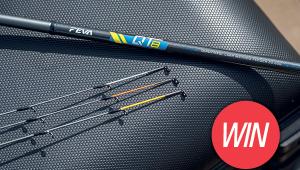The Magic Of Marinas
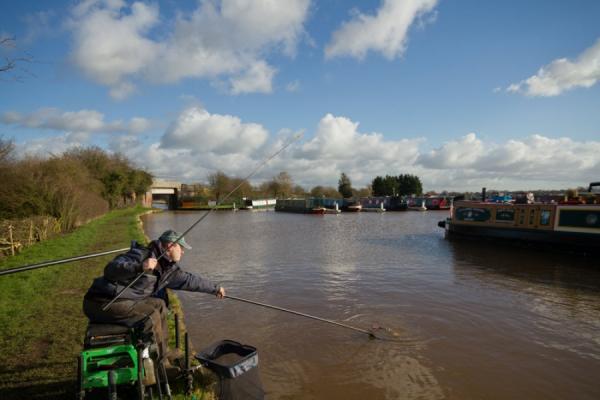
Lewis Breeze explains how to make the most of your peg, if you are lucky enough to draw opposite the moored boats in a marina.
Words and photos: Steve Martin
The UK’s canal system can be almost as busy as its motorway network during the summer months. However, once the cooler weather arrives, most canal boats are moved to moorings to overwinter in a marina. Once moored, the boats create the perfect sanctuary for fish to use as protection from predators in the clear-water conditions.

Marinas offer plenty of cover all year round, especially once the boats stop and the water clears.
Sadly, many of the marinas are off limits to angling, as they are set off the canal with no access, but in some parts of the country there are no barriers, so you are able to fish from the towpath – across to the boats or into the open water between them.
It’s safe to say that if there was a marina included in the match length, those pegs would be the ‘fliers’ that everyone would want to draw. However, once you arrive at the swim, it’s no normal canal peg, so how do you fish it?
Canal expert Lewis Breeze has fished the Venetian Marina near Nantwich, in Cheshire, since he was a lad. However, the fishing on the short section of the Shropshire Union Canal was stopped for a number of years, and it had only recently been reinstated, with the odd match now fished on it.
Lewis had picked a peg that was in the centre of the marina, well away from the lock to his right and the narrow bridge to the left. These were the entry points to the marina, so he wanted to avoid as much of the disturbance that any boat entering or exiting could have made had he fished closer to them.
With a boat moored directly across from Lewis, he explained that this, as you would expect, would be his main target area. He felt that the fish would be shoaled close to the cover, rather than in the deeper water of the main channel, even though the water was coloured. This was an unusual quirk of the canal, as the water usually goes clear in the cold.

Lewis started the session fishing a 5mm punch, but would go larger of the better fish turned up.
Roach and skimmers were Lewis’ main targets for the session, and due to the cover that marinas offer there are often some big specimens to be caught, which is why the moorings are seen as the hot pegs. He added that he expected to catch small fish early and hoped the bigger fish would move in later in the session. To maximise his chances, he would fish a bread line as his main line of attack, to catch anything, and a caster line to draw in the better stamp fish. He also added that he would have a third line to fish for a bonus perch down the track, as one big stripey can often be a game changer!
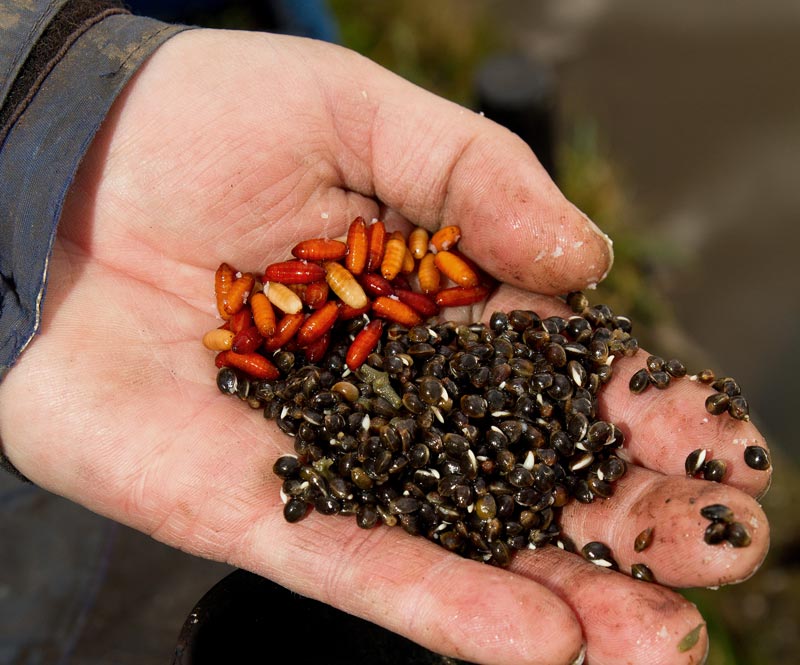
A helping of hemp boosted the drawing power of the casters!
The bread was to be fished at 13 metres – just off the boat, straight in front of Lewis – with the casters a few metres to the left. His theory was that the bigger fish would hang just off the main feed area, and by loose feeding casters regularly, it would gain their confidence to feed. The perch line was to be fed with a small helping of chopped worms and casters to the left at around six metres.
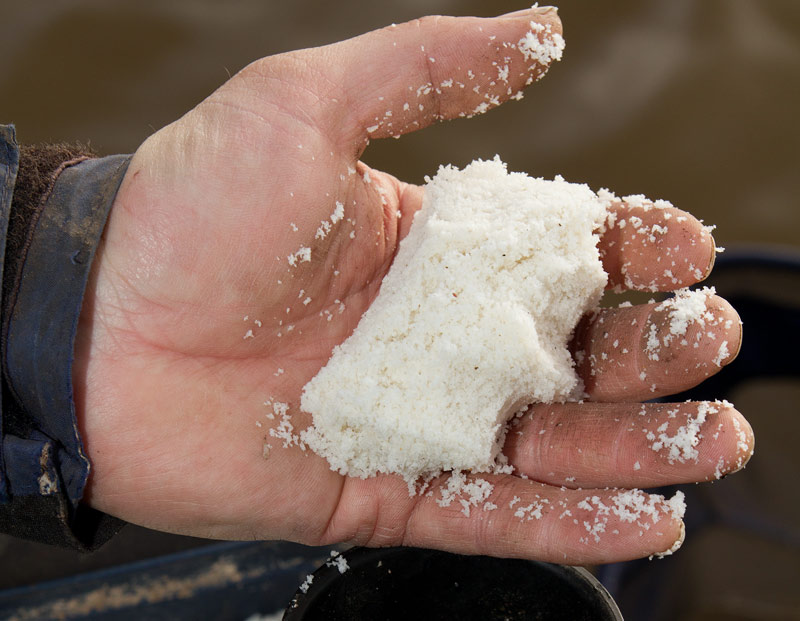
A firmly squeezed helping of bread to prime the punch line.
To fish the punch, Lewis attached a rig to his No2 Slip elastic, comprising a 4x12 Garbolino DC22 on 0.10mm main line. To this he added a 5in 0.07mm hook link with a size 18 Kamasan B511 hook. The rig was shotted with a spread bulk of No12s above the hook link.
For the caster line, Lewis had a 4x10 Preston PB8 set on 0.10mm main line with a 5in 0.08mm hook link and size 18 PR 333. The No12s were set ‘shirt button- style’ above the hooklength. That rig was attached to a No8 Slip elastic to cope with the bigger fish that Lewis expected to catch on the setup.
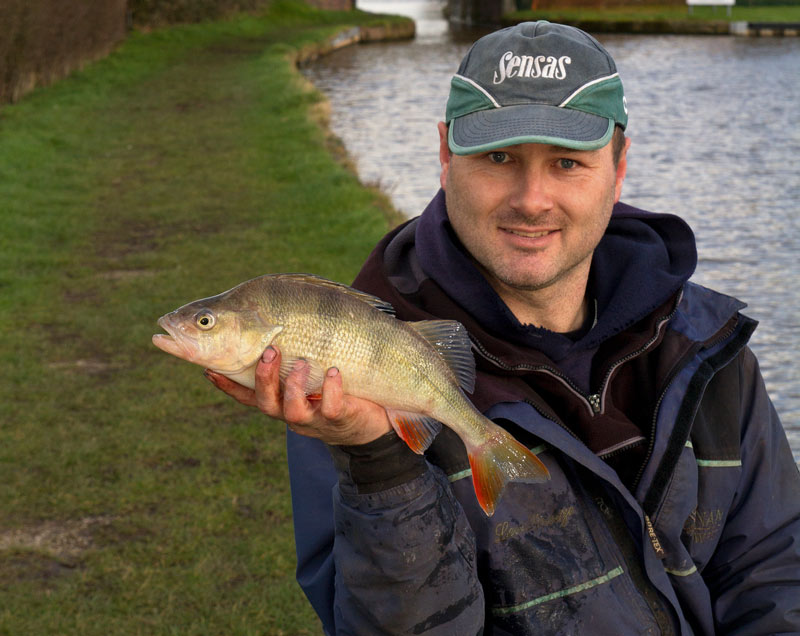
The perch line paid off late in the session with this bonus 2lb stripey
Both rigs were plumbed up to fish slightly overdepth, and as he did so, he pointed out that unlike a normal section of canal, the water at the top of the slope was quite deep. In fact, it was a good metre deep by the boat. Another clue as to why the fishing and the quality of the fish can be so good!
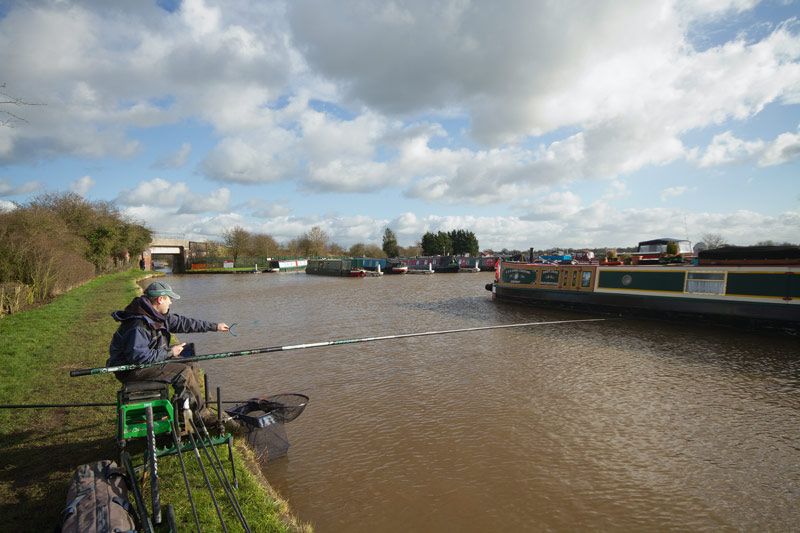
Positive loose feeding will draw the fish away from the boats
The perch rig was a lot meatier, as it needed to strike home the size 14 B560 hook – hence the reason for the 6-8 hollow elastic – and allow Lewis to play a bonus fish without fear of a break. The rest of the rig saw a 4x18 Sensas CCX2 set on 0.12mm main line with a similar strength 5in hook link. The loading was three No12s bulked directly above the hooklength and an olivette set a further 12 inches above the shot. This was set to fish a big worm hard on the bottom.

A lump of stodgy bread every put-in kept the fish on the deck
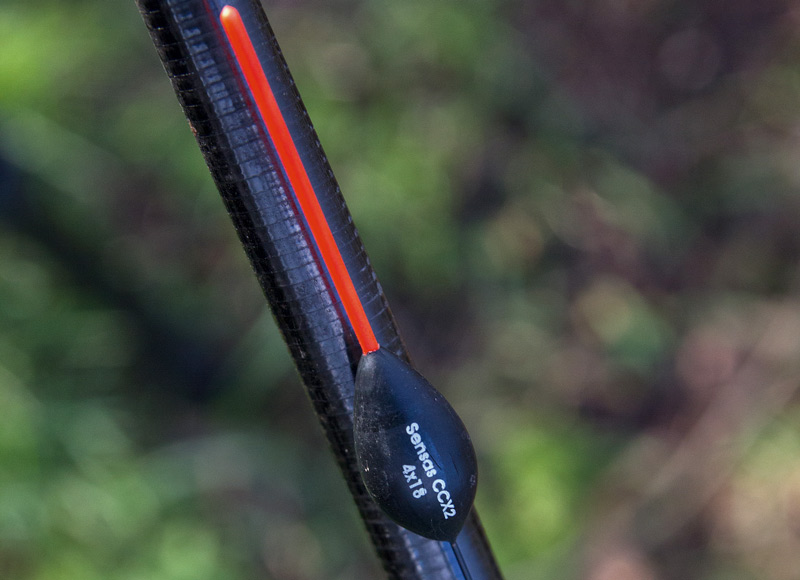
A 4x18 sensas CCX2 for the worm rig.
To kick-start the session, Lewis would feed a small baitdropper of chopped worms and casters down the track, where, he explained, he would leave the feed to attract any perch in the vicinity, topping it up every 30 minutes, but not fishing it for at least two hours. He might get one chance of a bite, so he wanted to give the feed plenty of time to draw a fish in.
He would feed hemp and casters on the shell line, and again not fish it for a while at the start to allow the fish time to locate particles. He would, however, ping a few casters over the top every 10 minutes.
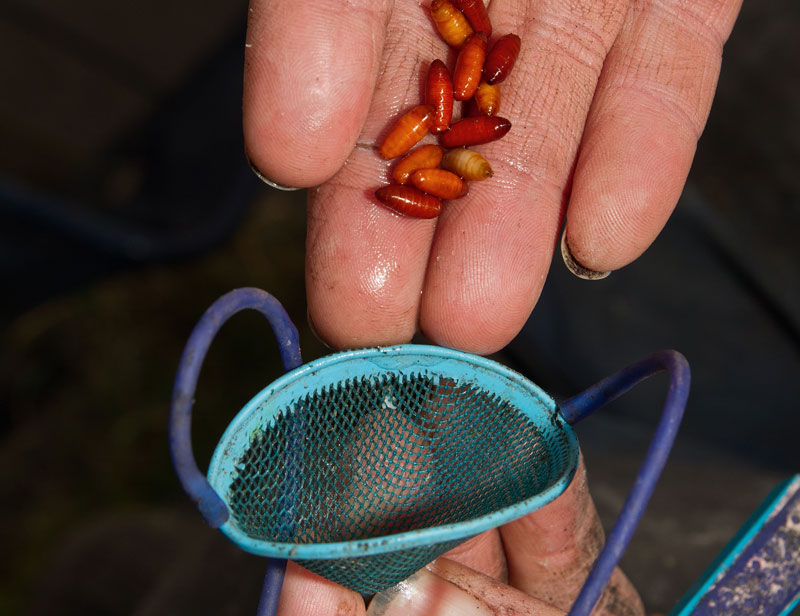
Casters were fed every 10 minutes at the start, then more frequently as the session progressed
The bread line would be primed with a big, fairly firm ball of liquidised feed, which Lewis had frozen, thawed and then passed through a pinkie riddle. This then created a light, fine, fluffy feed once water was applied by an atomiser, to bind it and give it some weight.
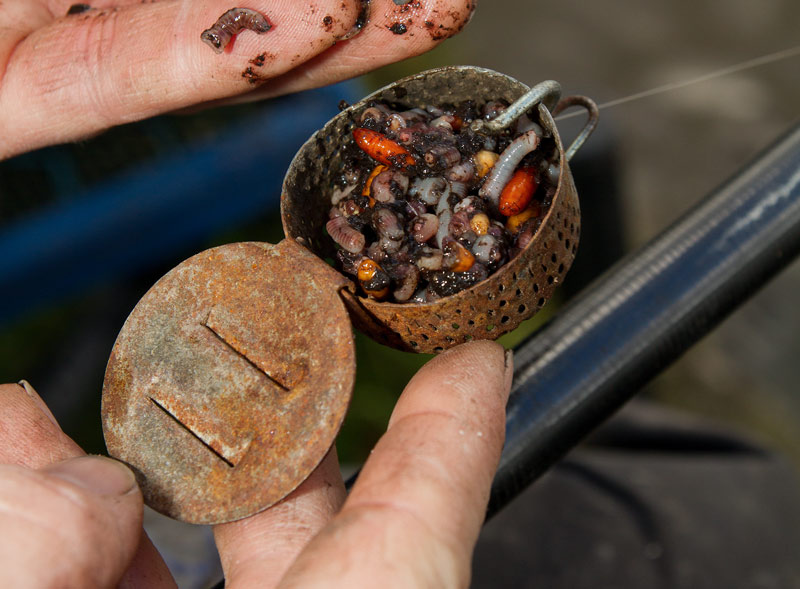
A small amount of chopped worms and casters to tempt the perch
The white crumb only formed part of the feed, though, as before he added the water Lewis also mixed in an equal amount of a dried bread mix, which he had prepared by drying slices of a white loaf in a low oven, then crumbled them up before finally passing it through a flour sieve to create an extra-fine feed. Once mixed, this finer feed would create a lingering cloud in the water, which would attract, but not fill the fish up. It was also very versatile, as by adding more water, the feed would become stodgy, so that it fell quickly to the bottom before breaking up, which made it perfect for topping up, once the bites started to slow.
Lewis stated that a firm squeeze of the bread mix was fine, as there was no tow on the water, so he wasn’t too bothered if the feed started to break down in midwater. Once the bread was fed he then added the extra water to form the heavier stodge, which he would feed later.
With all three lines fed, Lewis went straight over on the bread with a 5mm disc of punch, which saw his float dip within moments of the bait settling, and as he swung the fish to hand, he commented that it was one of the great things about bread on the canal – it’s an instant bait, and with that in mind, he added that he would only ever feed and fish the one bread line at a time, to ensure he didn’t miss out on any fish.
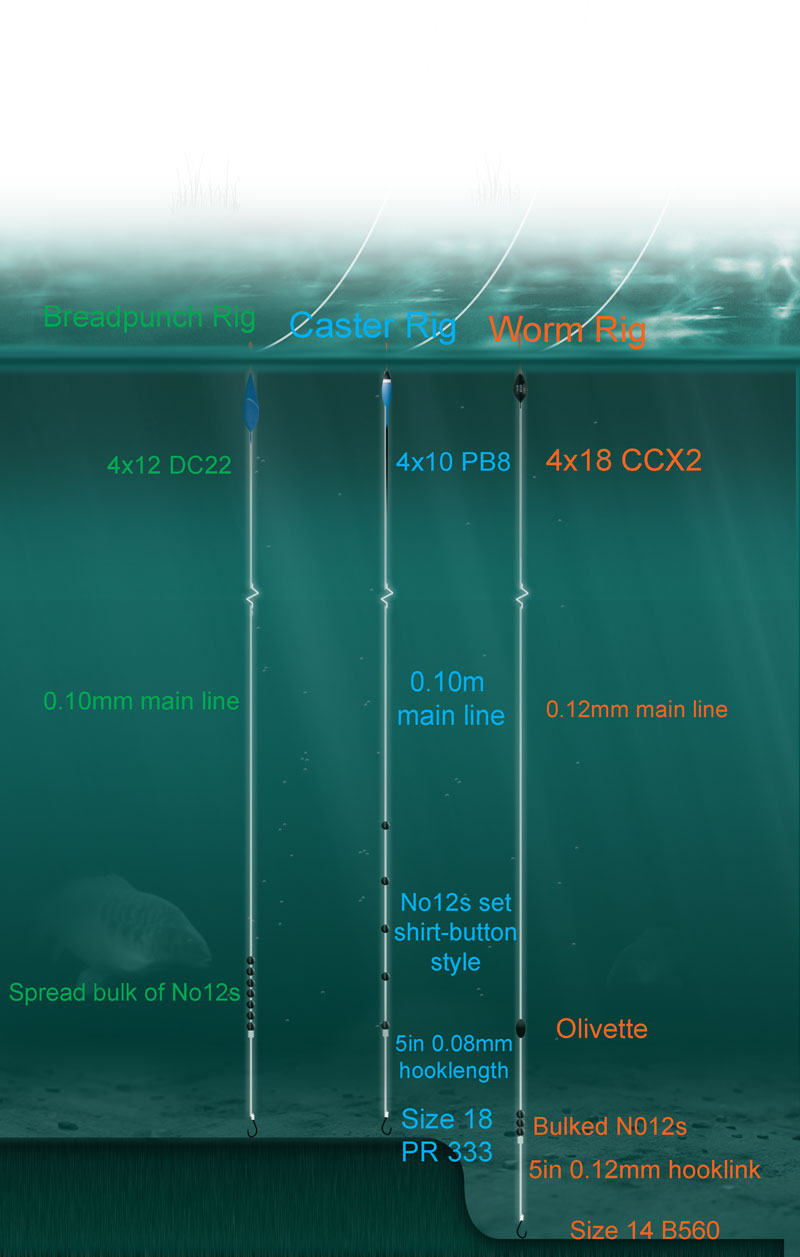
It was a small roach every put-in for Lewis in the first 30 minutes. He had banked on a few stamp fish to move in sooner, so to see if the bigger fish were hanging back from the initial line, he switched to the caster line.
That move failed to get any interest, so after another baitdropper of chop and casters was fed down the track Lewis returned to the bread line, where he now started to feed a small amount of ‘sloppy’ bread via a Toss Pot on every put-in, having first added more water to the feed. This modified crumb created a milky cloud on the way to the deck, without adding too much more food. He explained that with so much water to draw the fish from, you can risk being a little more positive with the feed to try and entice more into your swim. Lewis also upped the frequency of the loose-fed casters.
The extra feed did its job, as the bigger fish started to show, including the first skimmer of the session. However, the slop created another problem as Lewis was getting bites on the drop, as the fish came up to the slow-sinking bread. These were the smaller roach, which he was trying to avoid, and they were trashing the hook bait before it reached the bigger fish.
A quick fix was required, and to push the fish back down Lewis added some dry crumb to his sloppy feed, so that it became more stodgy. He also changed to a pinkie hook bait, which would survive the attentions of the smaller fish better than the punch. This resulted in him hitting more bites, but the fish were again on the small size.
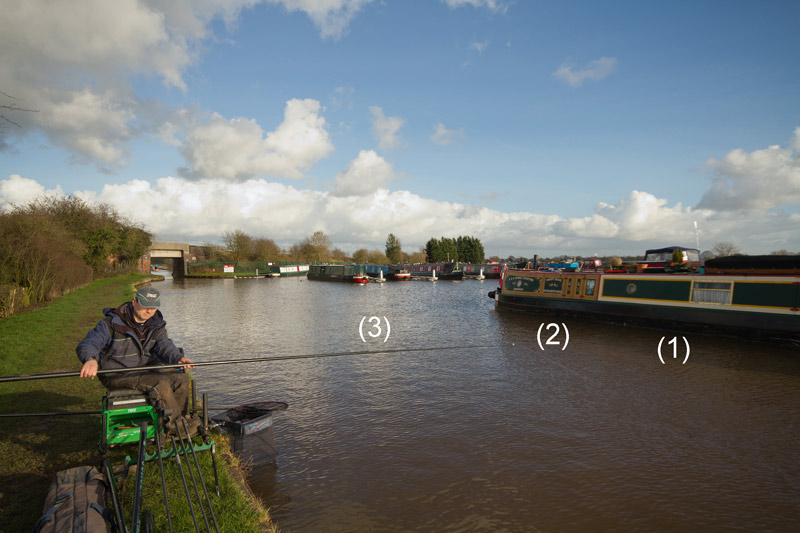
Lewis fished three lines on the day: (1) Bread directly in front, (2) casters to the left - away from the bread line - and (3) worms further to the left, down the track in the deepest water.
Two passing boats prompted Lewis to feed his perch line for a third time, before he had a second look on the casters. It was still slow, but he did start to get fish – better roach, plus a big skimmer. After catching the latter, he tried a worm head on the hook, which produced a few more good roach, but he had to wait a while for each fish.
Then a clue as to why the action wasn’t as good as he expected – the surface of the water over his bread line erupted, as a perch hit a shoal of small fish. That attack seemed to kill both silver-fish lines, so Lewis re-fed both, and also the perch line, after which he then decided to drop a big worm in the deep water.
A bite came almost immediately… from the smallest perch in canal! A second look produced a 4oz fish. It looked as if a nest of small perch had moved in over his feed, so Lewis had one more look on the worm, commenting that he’d given the other lines time to settle. The float danced and then dipped, and this time when he hit the bite, there was solid resistance, and a few moments later he had a bonus 2lb perch in the net.
Returning to the bread line, Lewis continued to catch small roach on pinkie, feeding bread, plus a bigger roach on a single maggot. However the bites were now at a premium. It seemed that the predator presence had spooked the fish somewhat, and time was up anyway.
Angler File
Name: Lewis Breeze
Age: 36
Team: Drennan Northwest
Sponsors: Sensas, Dave’s of Middlewich
MF says: Marina master
Venue File
Venue: Venetian Marina
Location: Shropshire Union Canal – Middlewich Branch, Barbridge Junction to Middlewich Juntion, Cheshire
Tickets: Canal & Rivers Trust Waterways Wanderer ticket £20
Number: 0303 040 4040
Like what you see?
Or buy a sinle issue
- Log in or register to post comments












